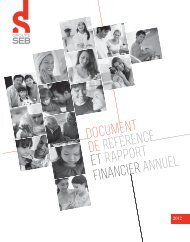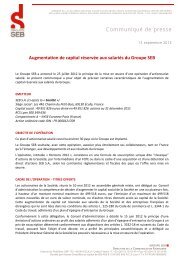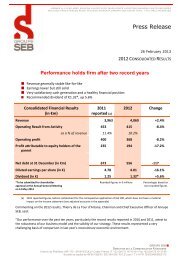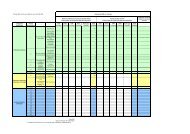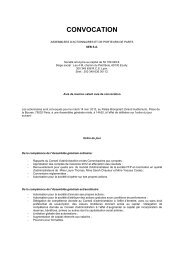Financial Report and Registration Document 2010 - Groupe Seb
Financial Report and Registration Document 2010 - Groupe Seb
Financial Report and Registration Document 2010 - Groupe Seb
Create successful ePaper yourself
Turn your PDF publications into a flip-book with our unique Google optimized e-Paper software.
3 NOTES<br />
CONSOLIDATED FINANCIAL STATEMENTS<br />
TO THE CONSOLIDATED FINANCIAL STATEMENTS<br />
Actuarial gains <strong>and</strong> losses arising from the effects of changes in actuarial<br />
assumptions <strong>and</strong> experience adjustments on plan obligations <strong>and</strong> assets are<br />
recognised in profit by the corridor method. Under this method, the portion<br />
of the net cumulative unrecognised actuarial gains <strong>and</strong> losses that exceeds<br />
the greater of 10% of the present value of the defined benefit obligation <strong>and</strong><br />
10% of the fair value of any plan assets at that date is amortised over the<br />
remaining service lives of the employees concerned.<br />
A provision is recorded in the balance sheet for any unfunded obligations,<br />
corresponding to defined benefit obligations not covered by plan assets, net<br />
of unrecognised gains <strong>and</strong> losses.<br />
For plans that have a surplus – corresponding to the excess of plan assets<br />
over the defined benefit obligation – an asset is recognised only when the<br />
criteria specified in IAS 19 are fulfilled.<br />
B) OTHER LONG-TERM BENEFIT PLANS<br />
Certain subsidiaries pay jubilees to employees who have completed a certain<br />
number of years service or offer employees “time savings accounts”. The cost<br />
of these long-term benefits is calculated on an actuarial basis <strong>and</strong> recognised<br />
in profit over the service lives of the employees concerned. Actuarial gains<br />
<strong>and</strong> losses are recognised immediately in profit during the period in which<br />
they are generated, as their deferral is not allowed under IFRS.<br />
Pension <strong>and</strong> other post-employment benefit costs are classified as operating<br />
expenses, except for the interest cost, which is included in other financial<br />
income <strong>and</strong> expense in accordance with the alternative treatment allowed<br />
under IAS 19.<br />
In accordance with IFRS 1 – First-Time Adoption of IFRS, cumulative<br />
actuarial gains <strong>and</strong> losses at 1 January 2004 were included in provisions<br />
for pensions <strong>and</strong> other post-employment benefit obligations at that date by<br />
adjusting equity. <strong>Groupe</strong> SEB has elected not to use the option available<br />
in the amended version of IAS 19 whereby entities may recognise actuarial<br />
gains <strong>and</strong> losses under defined benefit pension plans directly in equity as<br />
from 1 January 2006.<br />
C) SHARE-BASED PAYMENTS<br />
Stock option plans are measured <strong>and</strong> recognised in accordance with<br />
IFRS 2 – Share-Based Payment. Stock options represent a benefit for the<br />
grantee <strong>and</strong>, accordingly, are treated as part of the Group’s compensation<br />
costs. Option grants are not cash-settled, <strong>and</strong> the benefit is therefore<br />
recognised as an expense over the vesting period by adjusting equity,<br />
for an amount corresponding to the fair value of the underlying equity<br />
instruments. Stock options granted to employees of Group subsidiaries<br />
that are exercisable for SEB S.A. shares are deemed to be equity-settled<br />
share-based payments.<br />
Fair values are determined using the Black & Scholes option pricing model.<br />
This model takes into account the option exercise price <strong>and</strong> period, market<br />
data at the grant date (risk-free interest rate, share price, volatility, expected<br />
dividends) <strong>and</strong> grantee behaviour assumptions.<br />
IFRS 2 has been applied only to stock options granted after 7 November<br />
2002 that had not yet vested at 1 January 2005. As allowed under IFRS 1,<br />
options granted prior to 7 November 2002 have not been restated.<br />
1.4.11. Provisions<br />
In accordance with IAS 37 – Provisions, Contingent Liabilities <strong>and</strong><br />
Contingent Assets, a provision is recognised when the Group has a present<br />
obligation (legal or constructive) as a result of a past event, it is probable<br />
that an outflow of resources embodying economic benefits will be required<br />
to settle the obligation, <strong>and</strong> a reliable estimate can be made of the amount<br />
of the obligation.<br />
A) PROVISIONS FOR WARRANTY COSTS<br />
The Group provides a warranty on its products. The estimated costs of the<br />
warranty are accrued at the time of sale, based on historical data.<br />
This item also includes provisions for product recalls, which are set up when<br />
the recall is decided.<br />
B) PROVISIONS FOR CLAIMS AND LITIGATION<br />
As a general principle, all known claims <strong>and</strong> litigation involving the Group<br />
are reviewed by management at each period-end. All necessary provisions<br />
have been recorded to cover the related risks, as estimated after obtaining<br />
advice from outside legal advisors.<br />
C) RESTRUCTURING PROVISIONS<br />
The Group is considered as having a constructive obligation when<br />
management has a detailed formal plan for the restructuring, has raised a<br />
valid expectation in those affected that it will carry out the restructuring by<br />
starting to implement that plan or announcing its main features <strong>and</strong> no inflow<br />
of economic benefits is expected that would offset the costs of the plan.<br />
The amount of the related provision corresponds to forecast cash outflows<br />
under the plan.<br />
1.4.12. Off-balance sheet commitments<br />
For several years now, the Group’s reporting system has included detailed<br />
reporting of off-balance sheet commitments. The process provides for the<br />
reporting by consolidated subsidiaries, in their consolidation packages, of<br />
information about the following commitments that they have given:<br />
guarantees, endorsements <strong>and</strong> bonds;<br />
security interests (mortgages <strong>and</strong> pledges);<br />
commitments under non-cancellable operating leases <strong>and</strong> fi rm orders<br />
for fixed assets;<br />
other commitments.<br />
1.4.13. Transactions between owners<br />
Acquisitions or disposals of non-controlling interests that do not affect the<br />
Group’s control of a subsidiary are treated as transactions between owners<br />
<strong>and</strong> accounted for in equity. The carrying amounts of the subsidiary’s assets<br />
(including goodwill recognised upon obtaining control) <strong>and</strong> liabilities remain<br />
unchanged.<br />
In the event of a partial disposal leading to the loss of control of a subsidiary,<br />
the Group (a) derecognises the assets (including any goodwill) <strong>and</strong> liabilities<br />
of the subsidiary at their carrying amounts at the date when control is<br />
lost; (b) derecognises the carrying amount of any non-controlling interests<br />
in the former subsidiary at the date when control is lost; (c) recognises<br />
the fair value of the consideration received; (d) recognises any investment<br />
retained in the former subsidiary at its fair value at the date when control<br />
is lost; (e) reclassifies to profit or loss any gain or loss recognised in other<br />
comprehensive income <strong>and</strong> (f) recognises any resulting difference as a gain<br />
or loss in profit or loss attributable to the parent. The remeasurement at fair<br />
value of any investment retained therefore affects profit or loss.<br />
1.5. INCOME STATEMENT PRESENTATION<br />
1.5.1. Revenue<br />
Revenue corresponds to the value, excluding tax, of goods <strong>and</strong> services<br />
sold by consolidated companies in the course of their ordinary activities,<br />
after eliminating intra-group sales.<br />
72 FINANCIAL REPORT AND REGISTRATION DOCUMENT <strong>2010</strong> GROUPE SEB



